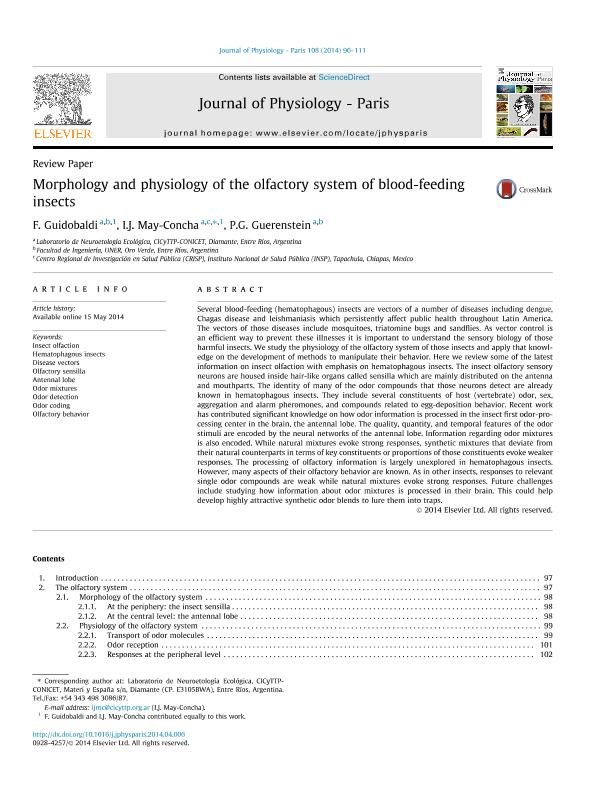Mostrar el registro sencillo del ítem
dc.contributor.author
Guidobaldi, Fabio

dc.contributor.author
May Concha, Irving Jesus

dc.contributor.author
Guerenstein, Pablo Gustavo

dc.date.available
2019-07-23T22:24:18Z
dc.date.issued
2014-04
dc.identifier.citation
Guidobaldi, Fabio; May Concha, Irving Jesus; Guerenstein, Pablo Gustavo; Morphology and physiology of the olfactory system of blood-feeding insects; Elsevier; Journal of Physiology; 108; 2-3; 4-2014; 96-111
dc.identifier.issn
0928-4257
dc.identifier.uri
http://hdl.handle.net/11336/80111
dc.description.abstract
Several blood-feeding (hematophagous) insects are vectors of a number of diseases including dengue, Chagas disease and leishmaniasis which persistently affect public health throughout Latin America. The vectors of those diseases include mosquitoes, triatomine bugs and sandflies. As vector control is an efficient way to prevent these illnesses it is important to understand the sensory biology of those harmful insects. We study the physiology of the olfactory system of those insects and apply that knowledge on the development of methods to manipulate their behavior. Here we review some of the latest information on insect olfaction with emphasis on hematophagous insects. The insect olfactory sensory neurons are housed inside hair-like organs called sensilla which are mainly distributed on the antenna and mouthparts. The identity of many of the odor compounds that those neurons detect are already known in hematophagous insects. They include several constituents of host (vertebrate) odor, sex, aggregation and alarm pheromones, and compounds related to egg-deposition behavior. Recent work has contributed significant knowledge on how odor information is processed in the insect first odor-processing center in the brain, the antennal lobe. The quality, quantity, and temporal features of the odor stimuli are encoded by the neural networks of the antennal lobe. Information regarding odor mixtures is also encoded. While natural mixtures evoke strong responses, synthetic mixtures that deviate from their natural counterparts in terms of key constituents or proportions of those constituents evoke weaker responses. The processing of olfactory information is largely unexplored in hematophagous insects. However, many aspects of their olfactory behavior are known. As in other insects, responses to relevant single odor compounds are weak while natural mixtures evoke strong responses. Future challenges include studying how information about odor mixtures is processed in their brain. This could help develop highly attractive synthetic odor blends to lure them into traps.
dc.format
application/pdf
dc.language.iso
eng
dc.publisher
Elsevier

dc.rights
info:eu-repo/semantics/openAccess
dc.rights.uri
https://creativecommons.org/licenses/by-nc-sa/2.5/ar/
dc.subject
Antennal Lobe
dc.subject
Disease Vectors
dc.subject
Hematophagous Insects
dc.subject
Insect Olfaction
dc.subject
Odor Coding
dc.subject
Odor Detection
dc.subject
Odor Mixtures
dc.subject
Olfactory Behavior
dc.subject
Olfactory Sensilla
dc.subject.classification
Otros Tópicos Biológicos

dc.subject.classification
Ciencias Biológicas

dc.subject.classification
CIENCIAS NATURALES Y EXACTAS

dc.title
Morphology and physiology of the olfactory system of blood-feeding insects
dc.type
info:eu-repo/semantics/article
dc.type
info:ar-repo/semantics/artículo
dc.type
info:eu-repo/semantics/publishedVersion
dc.date.updated
2019-07-23T12:59:37Z
dc.journal.volume
108
dc.journal.number
2-3
dc.journal.pagination
96-111
dc.journal.pais
Países Bajos

dc.journal.ciudad
Amsterdam
dc.description.fil
Fil: Guidobaldi, Fabio. Provincia de Entre Ríos. Centro de Investigaciones Científicas y Transferencia de Tecnología a la Producción. Universidad Autónoma de Entre Ríos. Centro de Investigaciones Científicas y Transferencia de Tecnología a la Producción. Consejo Nacional de Investigaciones Científicas y Técnicas. Centro Científico Tecnológico Conicet - Santa Fe. Centro de Investigaciones Científicas y Transferencia de Tecnología a la Producción; Argentina. Universidad Nacional de Entre Ríos. Facultad de Ingeniería; Argentina
dc.description.fil
Fil: May Concha, Irving Jesus. Provincia de Entre Ríos. Centro de Investigaciones Científicas y Transferencia de Tecnología a la Producción. Universidad Autónoma de Entre Ríos. Centro de Investigaciones Científicas y Transferencia de Tecnología a la Producción. Consejo Nacional de Investigaciones Científicas y Técnicas. Centro Científico Tecnológico Conicet - Santa Fe. Centro de Investigaciones Científicas y Transferencia de Tecnología a la Producción; Argentina. Instituto Nacional de Salud Pública; México
dc.description.fil
Fil: Guerenstein, Pablo Gustavo. Provincia de Entre Ríos. Centro de Investigaciones Científicas y Transferencia de Tecnología a la Producción. Universidad Autónoma de Entre Ríos. Centro de Investigaciones Científicas y Transferencia de Tecnología a la Producción. Consejo Nacional de Investigaciones Científicas y Técnicas. Centro Científico Tecnológico Conicet - Santa Fe. Centro de Investigaciones Científicas y Transferencia de Tecnología a la Producción; Argentina. Universidad Nacional de Entre Ríos. Facultad de Ingeniería; Argentina
dc.journal.title
Journal of Physiology

dc.relation.alternativeid
info:eu-repo/semantics/altIdentifier/url/https://www.sciencedirect.com/science/article/pii/S0928425714000175
dc.relation.alternativeid
info:eu-repo/semantics/altIdentifier/doi/https://doi.org/10.1016/j.jphysparis.2014.04.006
Archivos asociados
